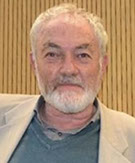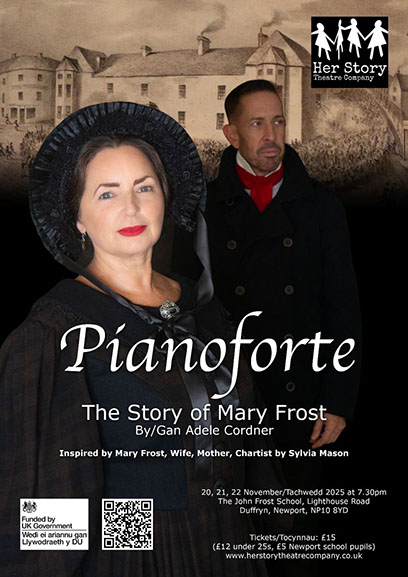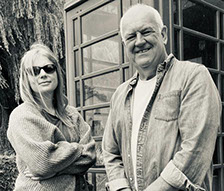Rhian E. Jones
 Rebecca Riots & Chartism
Rebecca Riots & Chartism
The Rebecca riots were a series of spectacular disturbances and direct action that spread across south-west Wales in the early 1840s. They were carried out by local farmers, workers and others who dressed in dramatic costumes and acted under the symbolic leadership of “Rebecca”.
This talk will look at the success of the rioters in resisting the imposition of tolls on road travel, for which they are best remembered. But it will also show that “Rebeccaism” was a wide-ranging popular movement, generated by the social, political and economic turbulence of the early industrial era. Protesters opposed not only road tolls, but also the New Poor Law and workhouses; enclosure and privatization of land; and a remote and neglectful ruling class. And Rebeccaism had connections with other protests in Wales and beyond – not least Chartism. Rebecca rioters and Chartists found both conflict and common ground as their movements evolved, leading local and national authorities to panic that connections between the two could swell into a revolutionary uprising.
Rhian is a writer, critic and broadcaster from Tredegar who now lives and works in London. She writes on history, politics and popular culture and is co-editor of Red Pepper magazine. Her previous books include Clampdown: Pop-Cultural Wars on Class and Gender (zer0, 2013); Petticoat Heroes: Gender, Culture and Popular Protest (University of Wales Press, 2015); Triptych: Three Studies of Manic Street Preachers' The Holy Bible (Repeater, 2017); Under My Thumb: Songs That Hate Women and the Women Who Love Them (Repeater, 2017) and Paint Your Town Red: How Preston Took Back Control and Your Town Can Too (Repeater, 2021).
__________________________________________________
Martin Wright
 The Chartist Landscape
The Chartist Landscape
An enhanced understanding of the spatial dimensions of the Chartist Movement and a re-evaluation of its relationship to agrarian radicalism have been two important developments in recent Chartist historiography. Katrina Navickas has interpreted Chartism within the context of a struggle over the use of public space that shaped radicalism from the 1790s to the middle of the nineteenth century, and Malcolm Chase led the way in demonstrating that agrarian radicalism was a more integral part of the Chartist Movement than had previously been recognised. Building upon the work of these historians, this paper will attempt an exploration of the ways in which both ‘land’ and ‘landscape’ were perceived in the Chartist imagination. It will examine the main influences upon Chartist thinking about the land, and consider the links and tensions within it between utilitarian perceptions of the land as a ‘people’s farm’ and more romantic conceptions of the landscape as something to be enjoyed in its own right. Drawing on Chartist literature, it will explore a range of cultural meanings that Chartists placed upon the landscape, and consider their significance in influencing the way Chartists viewed their own movement and its relationship to the regions and nations of the British Isles. It will, in other, words begin the process of constructing a psycho-geography of the Chartist Movement.
Originally from the English Midlands, Martin has lived for all of his adult life in mid-Wales. He studied at St. David’s University College Lampeter, and Cardiff University, and worked in adult education before joining the lecturing staff at Cardiff, where he has worked for the last fifteen years. He is interested in the history of socialism, radicalism and the British working class movement, and is author of Wales and Socialism: Political Culture and National Identity Before the Great War (2016) and co-author (with Nick Mansfield) of Made By Labour: A Material and Visual History of British Labour (2023).
_________________________________________________
Huw Williams
 Chartism in Merthyr
Chartism in Merthyr
Chartism in and around Merthyr Tydfil was BIG: in importance and in sheer numbers. The ripple effects could be discerned within what could be termed
"A Triangle of Activism" the three points being Merthyr Tydfil, Newport and Bristol.
So this presentation will place Merthyr Tydfil in an 1840s Wales context, highlight again the importance of Newport especially in 1839 and possibly introduce for the first time the pivotal role of Bristol within this Chartist mix.
Although semi-retired, Huw is an active historian, especially within his native Merthyr Tydfil and indeed across South Wales. He is a popular lecturer at a myriad of classes, has edited collections of local history, contributes to the Merthyr Historian journal and is still a keen student of 19th and 20th century Welsh History.
________________________________________________
Gavin Eynon
 The Trial of John Frost
The Trial of John Frost
This talk will look at John Frost’s trial for high treason, which began at Monmouth in December 1839. Unlike most defendants in criminal trials at the time, Frost was represented by lawyers of some stature, but did they do a good job in his defence? How strong was the case against him, and what issues, legal and otherwise, did the case raise? The talk is based on the transcript of proceedings at the shire hall in Monmouth, and will examine some of the personalities involved, and how events in the courtroom unfolded. It will seek to answer the question: did Frost get a fair trial, or was it just a showpiece?
Gavin was born and grew up near Abergavenny, but spent his working life as a solicitor in London, where he lives with his wife. Now retired, he has always had a keen interest in history, and has spent much time volunteering at a series of museums and heritage sites.
Raymond Stroud
 The John Frost Protest Coin
The John Frost Protest Coin
The campaign in support of imprisoned Chartists was one of the most important facets of radical activity in Britain during the period 1840 and 1841. Frost, Williams and Jones had left Britain for Tasmania on board the Mandarin and reached Hobart on 30 June 1840, but they were never forgotten. In Chartist meetings across the country the campaign to pardon the three ‘Welsh Martyrs’ and all other political prisoners was a regular theme. One approach adopted in spreading the word was by defacing coinage, usually pennies, and engraving them with a Chartist message. Newport Museum and Art Gallery holds one of these coins in its Chartist collection - a copper penny engraved with the words, ‘Frost’ and ‘Set Him Free’. The museum believes that this coin was engraved between 1839 and 1855 and, in my presentation to the Convention, I hope to explore this tactic, one aimed at securing the freedom of the three ‘Welsh Martyrs, together with other leading Chartist prisoners, many of whom were suffering in the aftermath of the Newport Rising of 1839.
Raymond was educated at Newport High School and Swansea University before engaging in post-graduate studies at Cardiff University. He taught history at King Henry VIII School in Abergavenny, before becoming Head of History at a secondary school in Cwmbran; he retired in 2015. He lives in Newport and has a particular research interest in the town, especially its Chartist associations, and has published a number of articles in Gwent Local History magazine. He is currently writing a book: Chartist Scarecrows: Five Prisoners of the Newport Rising of 1839.
Her Story Theatre Company

Her Story Theatre Company is delighted to perform a few short scenes from their powerful new play, Pianoforte, the Story of Mary Frost by Adele Cordner. Adele is a Newport-born writer who was inspired to write the play by Sylvia Mason’s wonderful book, Mary Frost, Wife, Mother, Chartist, which Adele first read after attending Sylvia’s talk at last year’s Newport Rising Festival.
Her Story Theatre Company is a new touring theatre company, based in Newport, which dramatises the extraordinary life stories of little-known Welsh women. The company recently completed a highly-successful tour of Daughter of Bala, the Story of Betsi Cadwaladr, starring Clare Drewett, and performing to over 1,000 people across Wales. The company aims to make their productions accessible to all through engaging and entertaining performances. Daughter of Bala is now available for bookings by community groups on the Arts Council Wales Night Out Scheme.
Pianoforte, directed by Clare Drewett, will be performed by Adele Cordner as Mary Frost, David Constant as John Frost and Clare Drewett as Dilys.
Her Story Theatre Company are delighted to be supported by Newport City Council, UK Government Shared Prosperity Fund.
Julian Hayman & Laura Wainwright
 Julian Hayman is a local musician and has been involved with music in Newport for almost 50 years. He has played with a wide range of artists including Jon Langford’s Men of Gwent, Fnools, Give Me Memphis, Carlton B Morgan, Abstract Man and Keith Levene.
Julian Hayman is a local musician and has been involved with music in Newport for almost 50 years. He has played with a wide range of artists including Jon Langford’s Men of Gwent, Fnools, Give Me Memphis, Carlton B Morgan, Abstract Man and Keith Levene.
He also made 5 albums with the folk singer and writer Charlotte Greig and returns to this sensitive side in his latest collaboration with musician, poet & painter, Laura Wainwright.
Julian and Laura will close the day with the Men of Gwent. The performance will include a song and a poem (written by Laura) dedicated to Mary Grant from Baneswell in Newport.
In November 1868, Mary and her young son, Charles, was bayoneted to death by unruly British soldiers.










